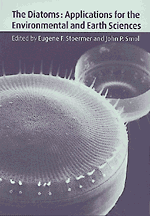Book contents
- Frontmatter
- Contents
- Contributors
- Preface
- Part I Introduction
- Part II Diatoms as indicators of environmental change in flowing waters and lakes
- Part III Diatoms as indicators in extreme environments
- Part IV Diatoms as indicators in marine and estuarine environments
- Part V Other applications
- 18 Diatoms and archeology
- 19 Diatoms in oil and gas exploration
- 20 Forensic science and diatoms
- 21 Toxic and harmful marine diatoms
- 22 Diatoms as markers of atmospheric transport
- 23 Diatomite
- Part VI Conclusions
- Glossary, and acronyms
- Index
23 - Diatomite
Published online by Cambridge University Press: 16 January 2010
- Frontmatter
- Contents
- Contributors
- Preface
- Part I Introduction
- Part II Diatoms as indicators of environmental change in flowing waters and lakes
- Part III Diatoms as indicators in extreme environments
- Part IV Diatoms as indicators in marine and estuarine environments
- Part V Other applications
- 18 Diatoms and archeology
- 19 Diatoms in oil and gas exploration
- 20 Forensic science and diatoms
- 21 Toxic and harmful marine diatoms
- 22 Diatoms as markers of atmospheric transport
- 23 Diatomite
- Part VI Conclusions
- Glossary, and acronyms
- Index
Summary
Introduction
Diatomite is a porous, lightweight sedimentary rock resulting from accumulation and compaction of diatom remains (class Bacillariophyceae). The delicate shell or frustule of diatoms, which gives diatomite many of its useful properties, is composed of amorphous opaline silica (SiO2·nH2O). Most diatoms fall within the 10 µm to 100 µm size range, although some are as large as 1 mm (Tappan, 1980). It is estimated that 1 cubic inch of diatomite may contain 40 to 70 million diatoms (Crespin, 1946). While the specific gravity (density) of diatom frustules is nearly twice that of water, the perforations and open structure of the frustule renders diatomite a considerably lower effective density (between 0.12 g/cm3 and 0.25 g/cm3) and high porosity (from 75 to 85%), able to absorb and hold up to 3.5 times its own weight in liquid (Cleveland, 1966).
Diatomite of varying quality has been deposited in freshwater environments since at least the Eocene (~50 million years ago) and in marine environments since the Late Cretaceous (~80 million years ago). The purity of diatomites depends on the presence and amount of both clastic particles (silt and clay) and of organic materials, which limit the utility of diatomite in industrial applications. Some high commercial-grade diatomite contains up to 90% SiO2, with minor occurrence of calcium carbonate, volcanic glass, and terrigenous particles (Cressman, 1962; Cummins, 1960). Diatom-bearing rocks with a higher terrigenous component (e.g., diatomaceous shale or siliceous shale) are commonly interbedded with diatomite.
- Type
- Chapter
- Information
- The DiatomsApplications for the Environmental and Earth Sciences, pp. 436 - 444Publisher: Cambridge University PressPrint publication year: 1999
- 4
- Cited by



